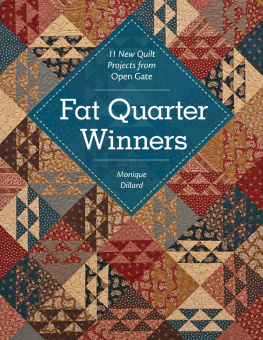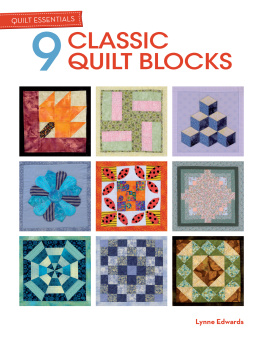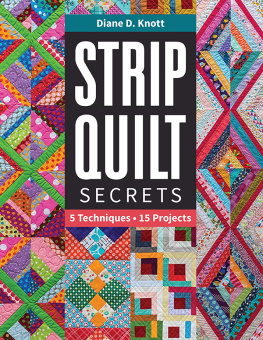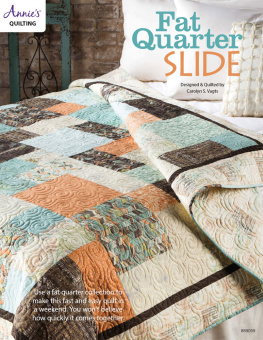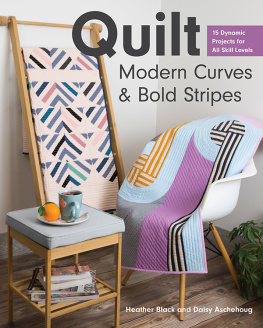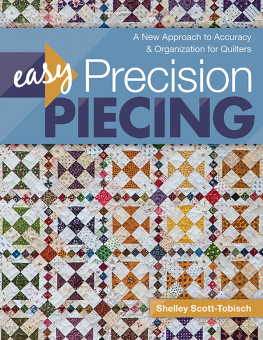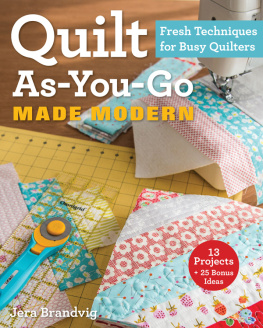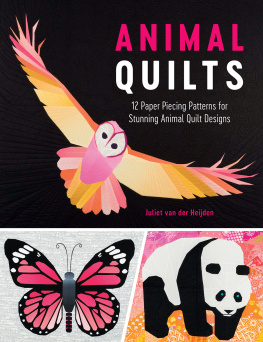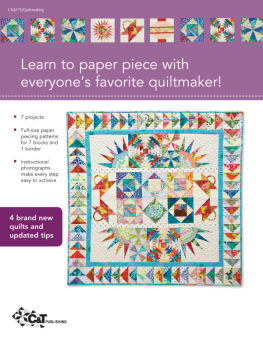Text and artwork copyright 2011 by Monique Dillard
Artwork copyright 2011 by C&T Publishing, Inc.
Publisher: Amy Marson
Creative Director: Gailen Runge
Acquisitions Editor: Susanne Woods
Editor: Lynn Koolish
Technical Editors: Carolyn Aune and Teresa Stroin
Copyeditor/Proofreader: Wordfirm Inc.
Cover/Book Designer: Kristy Zacharias
Production Coordinator: Jenny Leicester
Production Editor: Julia Cianci
Illustrator: Monique Dillard
Photography by Christina Carty-Francis and Diane Pedersen of C&T Publishing, Inc., unless otherwise noted
Published by C&T Publishing, Inc., P.O. Box 1456, Lafayette, CA 94549
All rights reserved. No part of this work covered by the copyright hereon may be used in any form or reproduced by any meansgraphic, electronic, or mechanical, including photocopying, recording, taping, or information storage and retrieval systemswithout written permission from the publisher. The copyrights on individual artworks are retained by the artists as noted in Fat Quarter Winners. These designs may be used to make items only for personal use or donation to nonprofit groups for sale. Each piece of finished merchandise for sale must carry a conspicuous label with the following information: Designs copyright 2011 by Monique Dillard from the book Fat Quarter Winners from C&T Publishing, Inc.
Attention Teachers: C&T Publishing, Inc., encourages you to use this book as a text for teaching. Contact us at 800-284-1114 or www.ctpub. com for lesson plans and information about the C&T Creative Troupe.
We take great care to ensure that the information included in our products is accurate and presented in good faith, but no warranty is provided nor are results guaranteed. Having no control over the choices of materials or procedures used, neither the author nor C&T Publishing, Inc., shall have any liability to any person or entity with respect to any loss or damage caused directly or indirectly by the information contained in this book. For your convenience, we post an up-to-date listing of corrections on our website ( or at P.O. Box 1456, Lafayette, CA 94549.
Trademark () and registered trademark () names are used throughout this book. Rather than use the symbols with every occurrence of a trademark or registered trademark name, we are using the names only in the editorial fashion and to the benefit of the owner, with no intention of infringement.
Library of Congress Cataloging-in-Publication Data
Dillard, Monique, 1967
Fat quarter winners : 11 new quilt projects from Open Gate / Monique Dillard.
p. cm.
ISBN 978-1-60705-190-9 (softcover)
1.Quilting--Patterns. 2. Patchwork--Patterns. 3. Quilts--Patterns. I. Title.
TT835.D548 2011
746.46--dc22
2010028182
10 9 8 7 6 5 4 3 2 1
Acknowledgments

I wouldnt be able to design my quilts without the support of my friends and family. I appreciate all the love and encouragement they give me. First, many thanks to my wonderful and talented friends who helped me piece the quilts in this book: Sue Glorch, Joyce Davis, and Kathy Rosecrance. Thank you to my fearless and creative machine quilters: LeAnne Olson, Sue Glorch, and Danette Gonzalez. Thanks to Katie Otto, who always has a way to turn my thoughts into the words I want to write. Thank you to my proofreaders, Kathy Rosecrance, Katie Otto, and Sue Glorch. Heartfelt thanks to my supportive and honest husband Billhe doesn't let me get away with much! Thanks to my brother, Mike Ayotte; his wife, Tina Stewart; and my nieces, Holly and Blaire, who are always on my side, will listen to me when I need to talk, and keep me laughing. Deep gratitude to my mom and dad, John and Noreen Ayotte, who are always encouraging and excited with each new step I take. And thanks, Dad, for folding all those patterns!

Introduction
I designed this book specifically to use fat quarters for all the quilts. Fat quarters are the greatest invention that the quilting world has ever developed! Cut on the fold of a half yard of fabric, fat quarters are 18 22 (approximately, depending on the fabric manufacturer), and quilts using rotary-cut pieces can make incredible use of just about the whole fat quarter. I love how there is very little waste, and, depending on how a quilt is designed, two fat quarters of coordinating fabrics can make multiple blocks of a quilt as opposite images of each other. Any fabric left over from a fat quarter can be employed as part of the binding (see Whist on ). Whenever I have fat quarters left over on a project, I also like to use them as part of the backing.
All the quilts in this book are named after the card games I grew up playing with my grandma and parents. My husband and I got to know each other over the game of rummy, and we now have regular games of pinochle with my parents and friends. Playing cards and quilting are two of my favorite pastimeswhat a great way to combine them with this book!
One of the extra features in this book is instructions that allow you to increase the size of your quilt by adding additional fat quarters. Want to make a twin-, queen-, or king-size quilt instead of a lap size? You can easily achieve this by creating extra blocks using additional fat quarters.
For example, my Speed quilt () instructs you to use 2 fat quarters to create 4 blocks. When you increase the size of the quilt, you increase it by multiples of 4 blocks (2 fat quarters for each 4 blocks). Therefore, if you want to make a twin-sized quilt, for example, you need 60 blocks (a total of 15 sets of 4 blocks, or a total of 30 fat quarters).
The quilts Kings Corner () are created with Square-in-a-Square units. Included in the directions are both the traditional instructions and the Fit to be Square method. I designed the Fit to be Square ruler to trim Square-in-a-Square blocks without bias edges. Using this ruler results in extremely accurate blocks.
The Whist () for more on Fit to be Square and Fit to be Geese rulers.
I very much enjoyed making all the quilts in this book; I hope you enjoy them as well. Hopefully you will be inspired to make one or two, or more, from this book. Quilting is addictivequilting using fat quarters is even more so!
General Instructions
This chapter contains the instructions for making the commonly used blocks in this book: Half-Square Triangle units, as well as Flying Geese units and Square-in-a-Square units, which can be made using either of the two methods described below.
Half-Square Triangle Units
Draw a diagonal line from corner to corner on the back of a light square. Match the light square with a dark square, right sides together. Sew from both sides of the line. Cut the pieces apart on the line, and press toward the darker triangle. Please note that in the directions, Half-Square Triangle units are made larger than needed so you can square them to the exact size.

Flying Geese Units
Traditional Flying Geese Method
On the backs of 2 squares, draw a diagonal line from corner to corner.

